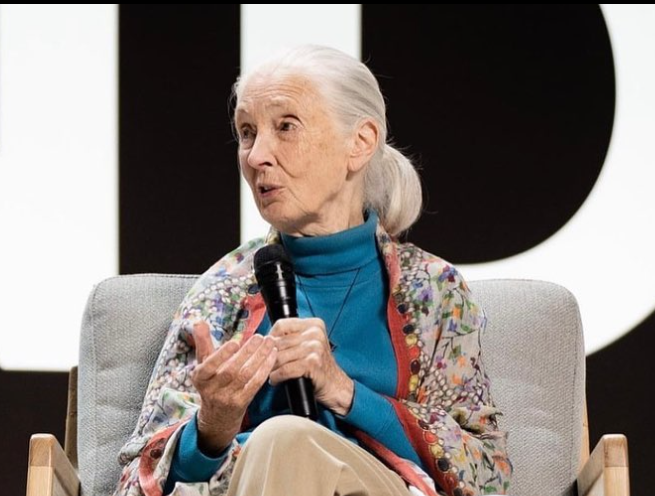Hugo Eric Louis van Lawick, also called Grub, was born into a life that was very different from others. He joined his mother’s research team against the tranquil backdrop of Gombe Stream National Park. From the time of his arrival in 1967, his infancy was not like any other; rather, it took place beneath vine-covered canopies and promise-filled skies. Even after his birth, his mother, Jane Goodall, the pioneering primatologist, kept researching chimpanzees. She combined parenthood and her research into one incredibly successful balancing act rather than separate them.

As a practical response to a very real problem, Jane once constructed a sizable protective cage for her infant, not as a scientific experiment. It was just not possible to leave a toddler alone while doing ethological observations because chimpanzees were frequently close by and leopards were hiding in the bush. She then put her son in the line of sight and continued working. This method was not merely a representation of her scientific sensibilities; it was a profoundly maternal deed that was influenced by necessity as well as a remarkably similar model in nature.
Biography of Hugo Eric Louis van Lawick (Grub)
| Name | Hugo Eric Louis van Lawick |
|---|---|
| Nickname | Grub |
| Date of Birth | March 4, 1967 |
| Birthplace | Gombe Stream National Park, Tanzania |
| Mother | Jane Goodall (Primatologist & Anthropologist) |
| Father | Hugo van Lawick (Wildlife Photographer) |
| Citizenship | British-Dutch |
| Childhood Environment | Lived in remote nature, near chimpanzees |
| Unique Upbringing | Raised in protective cage while mother worked |
| Known For | Being Jane Goodall’s only child |
| Marital Status | Private (limited public record) |
| Public Role | Rare media appearances, low profile |
| Reference |
Hugo saw nature as his daily backdrop while growing up in Gombe, not through screens or textbooks. While his mother documented the social systems of chimpanzees, he observed them roaming freely. His playground spanned savannas, riverbanks, and winding woodland paths, in contrast to most kids whose backyards are fenced in. But even though Hugo was the son of one of the most well-known conservationists in the world, his life took place out of the spotlight.
Hugo van Lawick, his father, was a Dutch wildlife photographer who frequently traveled overseas to photograph wildlife in the Serengeti and other places. His vision helped frame Jane’s breakthrough work. They eventually divorced amicably in 1974 as a result of their divergent schedules—she chasing behavioral data through dense shrubbery, he chasing light through a lens. A shared kid and film documentary had resulted from their professional synergy, but their different paths were unavoidable.
Hugo’s story is, in many respects, a purposefully simple one. He never took credit for his mother’s success or used her international renown to establish a public persona. As Jane was awarded the French Légion d’Honneur and the U.S. Presidential Medal of Freedom, Hugo withdrew into a life that has been repeatedly characterized as quiet and intensely private. It is clear from recent interviews and books on Jane that she never put any pressure on him to follow in her footsteps. Rather, she let him be unaffected by fame and wonderfully unrestricted to be himself.
This decision is very different from many celebrity children. From Jaden Smith’s alternative career in music and fashion to Brooklyn Beckham’s dalliance in photography, children of famous people are frequently subjected to relentless comparison. But Grub was remarkably disciplined in avoiding the pull of expectation. In the era of digital footprints, it is especially uncommon for his name to be mentioned in tabloids and for there to be so few public records about his life.
Jane Goodall’s strong emotional intelligence and scholarly education both influenced her approach to motherhood. According to her, chimpanzee mothers are “exceptionally durable in their attentiveness,” and she aimed to emulate that same level of intimacy. She was frequently just a few meters away from her son throughout her busiest research years, which kept her heart and eyes alert to his presence. At a period when working women were still struggling for acceptability, particularly in scientific circles, her intuitive, holistic, and thoughtful parenting was notably groundbreaking.
Jane stayed unmarried after her second marriage to Derek Bryceson in 1975, which ended with his death in 1980. She concentrated her efforts on advocacy, giving speeches, and growing her institute. Even while she spoke to halls full of conservationists and policymakers, Hugo continued to be the focal point of her more private thoughts and her emotional fulcrum. Although their relationship is not well documented, it was quite evident in her memoirs and sporadic interviews.
Grub’s story raises an intriguing question regarding legacy: is it possible for someone to subtly carry on a tradition without serving as its spokesperson? His lack of public appearances, his limited media presence, and his refusal to become a spokesperson for his mother’s work all point to a different kind of legacy—one that was lived rather than announced. And in today’s world, that is really uncommon.
Silence is frequently interpreted by society as absence. In Grub’s case, however, the silence appears to be chosen rather than forced. Even though he was associated with one of the most renowned scientific brains of the 20th century, his choice to remain out of the spotlight has its own weight. While children of celebrities frequently grow up to be influencers by default, Hugo became something perhaps more grounded—someone who lived in harmony with nature rather than shouting about it.
Hugo’s name has periodically reappeared in the last ten years as Gen Z environmentalists have taken a renewed interest in Jane Goodall’s writings. Young activists view Jane’s legacy as fundamental, especially those who are pursuing careers similar to those of Mya-Rose Craig or Greta Thunberg. However, people frequently overlook the icon’s backstory. That story is brought back into focus by Hugo’s life, particularly for people who choose very effective and deeply personal effects over loud and attention-seeking ones.
Hugo Grub van Lawick has maintained not just his personal space but also the integrity of his mother’s goal by exercising strategic restraint and respect for privacy. His modest life provides a different model for preserving a legacy—one based on decisions made away from cameras rather than on megaphones—as the world deals with more pressing environmental issues. There’s something deeply profound in the quiet.











